1984 Dallas Grand Prix race report
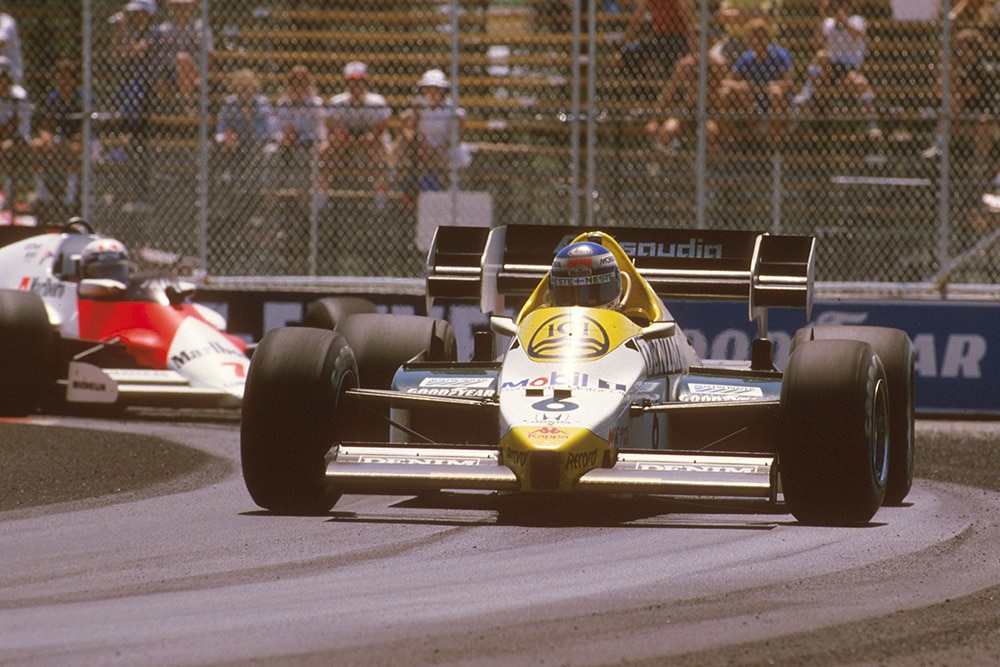
Keke Rosberg took a first win of the season for Williams
Motorsport Images
Slowest through the streets . . .
Looking back, the first Dallas Grand Prix provided a few surprises, not least the fact that it turned out to be the slowest circuit on the current Grand Prix programme — Keijo Rosberg’s Williams FW09-Honda came home the winner, on a dramatically deteriorating surface, at an average speed a whisker over 80 mph. That was significantly slower than many people had expected for the 2.42-mile Fair Park circuit, set in the centre of the Texas fairground in the middle of the oil-rich Texas city, but then many people considered it to be something of a minor miracle that the race took place at all.
If we examine this inaugural Dallas Grand Prix objectively, it is difficult to avoid the conclusion that insufficient foresight and preparation were brought to bear on the problems of organising it in the first place. Over the past few years, with conventional established circuits finding it increasingly difficult to meet the financial demands of the Formula One Constructors Association, so the trend has been increasingly away from established race tracks to events staged on makeshift road circuits.
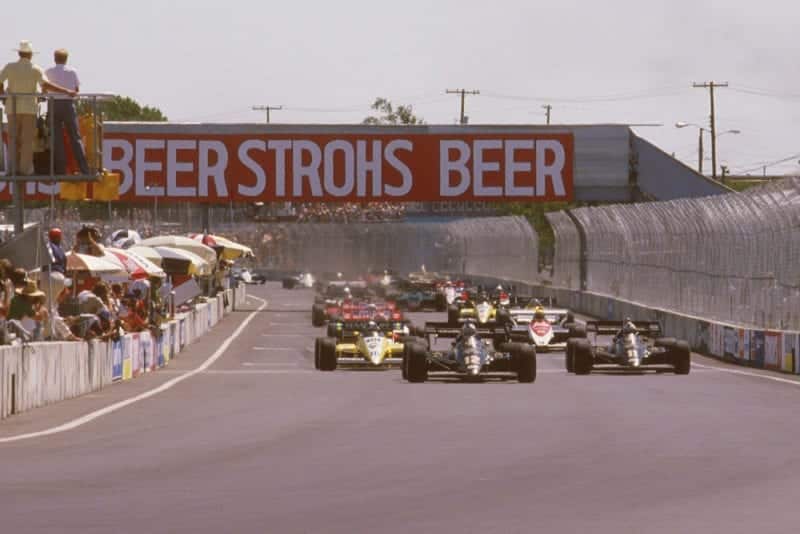
Nigel Mansell leads Elio de Angelis and Derek Warwick at the start
Motorsport Images
This trend has been particularly noticeable in the United States and the Formula One teams, whose level of financial expectation has snowballed relentlessly since the mid-1970s, seem now prepared to compromise their credibility by participating in races just about anywhere that promoters are prepared to put up the necessary capital. If you were adopting a cynical point of view, you would necessarily come to the conclusion that, as long as the money is right, every other facet of the Formula One operation will be subjugated to the business of staging that race, come what may. Having said all that, it should be recorded that the Dallas Grand Prix organisers went about the task of staging their first World Championship race with a grace, good-humour and tolerance that deserves considerable credit. It must have come as something of a surprise to them that, having had their facility approved by the FISA, for the drivers and teams to arrive and embark on what amounted to a non-stop programme of complaining about the state of the track and other facilities. Dallas co-promoter Larry Waldrop, at least, seemed to have got the measure of the Formula One fraternity pretty quickly when he remarked that “F1 drivers are the biggest prima donnas in sport . . . they bitch about everything”. Even some team managers couldn’t but smile at that remark, publicised in one of the leading Dallas newspapers, as it seemed to be right on the nail!
Yet, taking another point of view yet again, there was more than a little substance in the drivers’ complaints. It wasn’t their fault that FISA seems to have dropped its stipulation that any new circuit should be obliged to stage a major meeting, as proof of its competence, prior to organising a World Championship event. Nor was it their fault that the circuit surface broke up in such a disgraceful fashion as it did: the race morning warm-up session had to be cancelled while seriously deteriorating sections of the track were subjected to hasty remedial work with quick-drying concrete. It was by no means an ideal situation and what made the whole affair doubly frustrating was the fact that we’ve seen all these sort of problems before — even the first World Championship Grand Prix at Long Beach suffered from dramatic organisational problems on its first day of practice back in 1976. What’s more, Long Beach had been obliged to stage a preparatory Formula 5000 race the previous autumn, so what chance had Dallas got of getting through its first meeting without any problems?
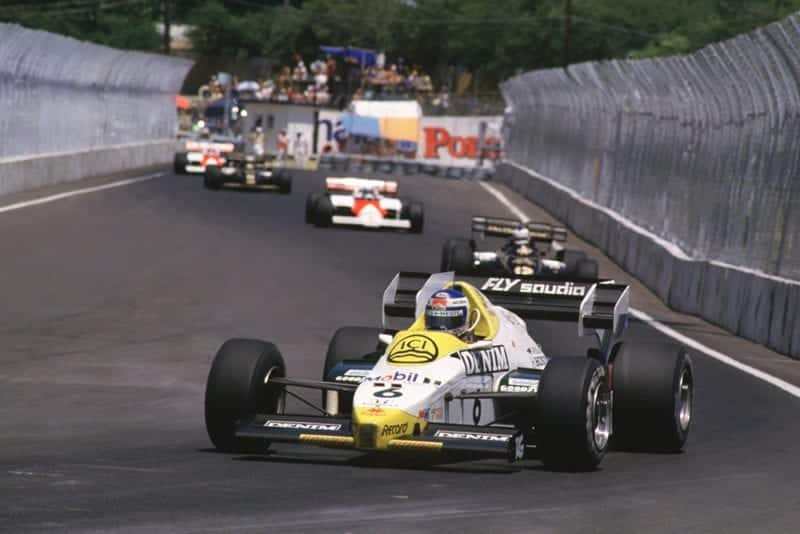
Rosberg charged through from 8th to win
Motorsport Images
The circuit was more interesting and varied than Detroit, although as far as television viewers were concerned the race might have been in Dallas, Long Beach, Las Vegas or Detroit. The visual impression provided was the usual concrete-barriered rabbit warren of bland roads round which the cream of the World’s international driving talent slipped and slid their way at a totally underwhelming 80 mph-plus. By good fortune, the race provided enormous entertainment, but it could just have easily been a bland walkover with the cameras focussing mindlessly on the leading car. We should be thankful for small mercies!
Qualifying
With the circuit surface breaking up from the start of practice, all the technicalities and subtleties of Formula One went out the window as the drivers concentrated on the business of setting their cars up in the most easy-to-drive trim for an anticipated two hours’ purgatory in the sweltering Texas summer heat. Even in Brazil and Buenos Aires the writer has not encountered such searing heat and, with the temperatures nudging over 105-deg(F) on race day, cooling tubes sprouted from within most cockpits in an attempt to keep the occupants as comfortable as possible. With this heat. combined with the dreadful state of the track surface and the proximity of the unyieIding unyielding concrete walls, it is not surprising, perhaps, that so many competitors ended their race with bent suspension or missing wheels.
Most of the quickest qualifying times were set on Friday afternoon, before the track surface had a chance of deteriorating. Nigel Mansell did a good job at the wheel of his Lotus 95T to take the first pole position of his career in 1 min 37.041 sec, his team-mate Elio de Angelis making it an all-black and gold Hethel front row with 1 min 37.635 sec. As an interesting confirmation of the fact that “first out was fastest”, nobody in either of the official sessions managed to match Niki Lauda’s McLaren best of 1 min 36.3 sec, set during the first unofficial session on Friday morning. One should also add that it can be taken as a reflection of the state of the crumbling track that Lauda managed to crash quite heavily in both Friday sessions. Well, nodded some sage observers, if he can’t cope, what hope is there for the rest of them?
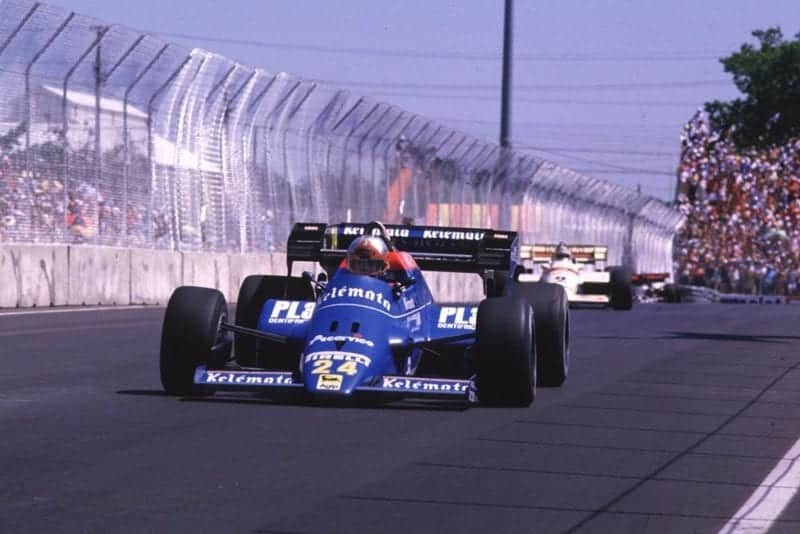
Piercarlo Ghinzani took a surprise 5th for Osella after starting way down in 18th
Motorsport Images
The only quick runner to improve his time on Saturday was Renault’s Derek Warwick, the Englishman recording a 1 min37.708 sec best to line up third on the inside of the second row. Derek and team-mate Patrick Tambay, now happily fully recovered from his recent leg injury sustained at Monaco, approached the task of setting up their Renault RE50s in different ways and Tambay was the first to admit that his team-mate had taken the right route. Most observers agreed that the Englishman’s lap time had been highly impressive, set as it was on relatively hard Michelin rubber which seemed particularly suited to the dusty, dirty track surface. Tambay wound up 1.2 slower down in 10th place on the grid.
In the Ferrari pit René Arnoux had raised the team’s morale considerably with third quickest time on Friday, only being dislodged the following afternoon by Warwick’s quickest lap. All three 126C4s present were equipped with the latest development of the Marelli / Weber electronic injection system, both Arnoux and Alboreto reporting that its response out of the corners seemed very much improved, although the Ferrari seemed to ride the bumps in a taut and uncomfortable manner. Arnoux achieved his time despite a spin into one of the walls, necessitating a quick pit stop for attention to damaged rear bodywork and aerofoil, but Alboreto’s quickest lap was spoilt when Philippe Alliot crashed his RAM quite badly and the Italian encountered waved yellow flags at the scene of the accident. Alliot happily emerged unhurt from his off-course excursion, but his car was too badly damaged to be repaired “on site”, so he was unable to take any further part in the weekend’s proceedings.
Despite his accident in Friday qualifying, at the wheel of the spare McLaren MP4/2, Niki Lauda wound up fifth fastest overall with team-mate Alain Prost a couple of places further back. The World Championship leader was another to have his best run spoilt by Alliot’s accident and an incorrect nomination of Michelin rubber on Saturday afternoon saw neither McLaren driver bother to use his second marked-up set.
Of the new boys, Ayrton Senna was raising a few eyebrows with his speed at the wheel of his Toleman TGI84 powered by the latest Brian Hart 415T development engine, a 1 min 38.256 sec best earning him a splendid sixth place on the grid — a fair barometer of his talent, perhaps, bearing in mind that he started the weekend on equal footing with all his more experienced rivals who had also never driven on the Fair Park track before! After his team-mate Johnny Cecotto crashed his race car beyond immediate repair on Friday, relying on the spare car for the remainder of the weekend, neither driver was allowed out during the final official session just in case the team ran out of cars.
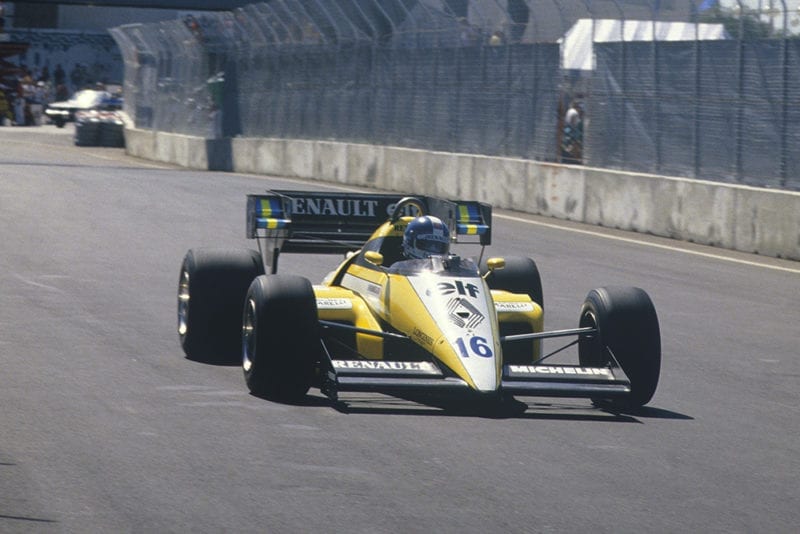
Renault’s Derek Warwick qualified 3rd but didn’t make it to the finish
Motorsport Images
Senna’s former F3 sparring partner Martin Brundle was not so fortunate. On his very first serious lap during Friday’s qualifying session he crashed his Tyrrell 012 quite heavily, breaking bones in both his feet and ending up in hospital as a result. Practice was stopped for almost half an hour while the unfortunate Englishman was taken away for medical attention and, although he was sufficiently fit to fly home on Sunday night (British Caledonian generously and thoughtfully upgrading his ticket to first class in order that his heavily bandaged feet would be more comfortable) to be admitted to hospital for further surgery. It’s expected that the young Tyrrell driver will be out of racing for between six weeks and two months.
Of the other notable teams, Brabham had produced a brand new BT53 for Nelson Piquet to drive, replacing the machine badly damaged in the Detroit start line fracas, but the installation of an even larger oil radiator in the nose upset the car’s handling and both BT53s reverted to the original small radiator layout (with an additional cooler at the front of the left-hand side pod) for the second day. By this time the opportunity for really quick laps seemed to be over (didn’t anyone tell Warwick?) and, when the grid was published, we had the unusual sight of Corrado Fabi and Piquet, in that order, side by side on the sixth row of the grid. On this rare occasion the BMW-engined can had even been out-qualified by Rosberg’s Williams-Honda FW09, the only major changes to which involved the adoption of FW07 front suspension uprights for the Dallas race. The Finn admitted, with his customary candour, that the car still understeered. . . .
In the second half of the grid Eddie Cheever was doing a good job sustaining an advantage over Riccardo Patrese in the Alfa Romeo team, while in general the also-rans were much in the same order as usual, skirmishes with concrete bariers resulting in the anticipated spate of broken wheels, deflated tyres and scuffed bodywork. Since the Arrows team appeared to have run out of Cosworth-engined machines, both Surer and Boutsen were entered in BMW-powered A7s, but that seemed to do little to their overall level of competitiveness. Down at the back, Jacques Laffite was making something of a mockery of his position in a supposedly top-class team, managing a best time almost five seconds slower than Rosberg: the Frenchman has clearly given up and is no longer prepared to drive at nine-tenths at the wheel of what he clearly considers to be a less than competitive car. He will not be retaining his place in the Williams team next year.
Race
On Saturday evening an ill-timed 50-lap Can-Am contest was all that was required to churn the circuit up into a fine old mess and the race morning warm-up session for the Grand Prix cars was cancelled as frantic, last-minute resurfacing work was carried out against the threat of a boycott, led by Niki Lauda and Alain Prost. Up to half an hour before the start, an absurd “will they, won’t they” atmosphere prevailed in the pit lane with few people really knowing whether the race was on or not. However, with World-wide television coverage opening at 11.00 am (the scheduled race start time) there was a pretty persuasive reason for everybody to get strapped into their cars and get on with it, even though some did so with something less than good grace. Some onlookers stood and shook their heads at the so-called “professionalism” of a business which transports more than twenty specialised racing cars half-way across the world and then finds itself faced with a circuit which is nowhere near up to the standards expected. All this eventually has to come down to FISA muddling and apparent inability on the part of this governing body to uphold precise and specific circuit requirements. As things stand at the moment the whole licensing procedure seems too haphazard.
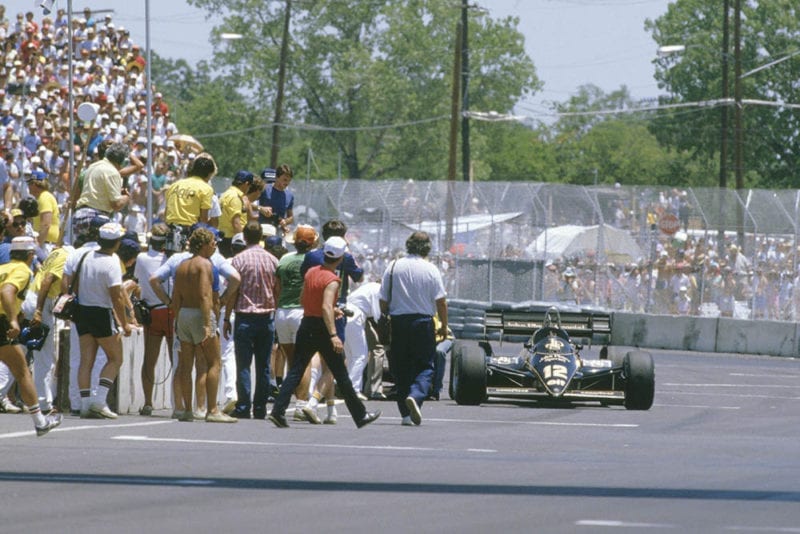
Crowds gather round Nigel Mansell after he collapsed whilst trying to push his car to the finish
Motorsport Images
Happily for the promoters, at least they had a race, and the crowds cheered as pole position man Nigel Mansell went straight into the lead as the starting lights blinked to green. Chased by a tightly packed bunch which was initially headed by team-mate Elio de Angelis, Mansell was under quite a lot of pressure from the outset, but he simply got his head down, ignored all the intimidating and varyingly coloured nose cones which eased up alongside his cockpit from time to time, and kept ahead for the first 35 laps.
Mansell has been criticised a lot recently by many magazines, including MOTOR SPORT, but on this occasion the writer honestly believes that any of the brickbats aimed at the Englishman once the race was over were totally unjustified. He started from pole position, made the best start and then proceeded to keep the field behind him for more than half the race — precisely what he is paid to do by Team Lotus. Having watched the race first-hand, and subsequently studied video tapes, he was nothing more than “unhelpful” to his pursuers and his alleged baulking was certainly not unusual by contemporary Grand Prix standards. He glanced a wall with his right rear wheel during the course of the contest, but then so did Prost, Lauda and a host of others. However, after the race, Rosberg blasted Mansell’s tactics, complaining “we don’t drive like that in Formula 1” at the post race press conference. Really?
At the end of the day, however, Rosberg was the only one who had any position of strength from which to complain about Mansell — he, alone, had carved a path ahead of the Lotus 95T and survived to the end of the race. Rosberg was like a dog with a bone once he had hauled his Williams FW09 up into second place, harrying Mansell all round the circuit until he found a gap and slipped through. Once the Lotus driver’s challenge was broken, he began to drop back down the field, eventually grazing another wall and stopping for fresh tyres. The usually smooth Alain Prost now began to worry Rosberg with his McLaren and the Frenchman, perhaps inevitably, slipped through to take over the lead on lap 49. By that time Frost had already tapped a wall with his McLaren’s right rear wheel and the normally meticulous Frenchman had another surprise in store for the crowd: on lap 59 he glanced another wall and almost immediately pulled up out on the circuit with a broken right front wheel rim and deflated Michelin. Four laps later his equally smooth team-mate Niki Lauda stopped at the same point after he, too, had knocked the right rear wheel of his McLaren.

Rosberg takes the chequered flag
Motorsport Images
Rosberg thus inherited the lead once again and drove on to a well-judged victory after a race in which he had used all his lightning reflexes and judgement to keep his car away from those walls, in one piece, until the end of the 67 lap event. His triumph provided a welcome morale-booster for the troubled Williams team which has not been enjoying its first season with turbo power as it had hoped. It was only the third World Championship Grand Prix success for Rosberg, despite the fact that he won the title in 1982. As always, a race so unpredictable as the first Dallas Grand Prix was fraught with “if only” tales. If only Derek Warwick hadn’t attempted to outbrake Mansell down the outside into one of the tight chicanes on lap 11, the Renault driver spinning off into the tyre barrier with nothing more than bruised pride. . . If only Rene Arnoux’s Ferrari C4 hadn’t failed to start on the dummy grid, received a push start and then been obliged to climb up through the field from its eventual starting place at the back of the grid . . . Arnoux’s performance proved to be one of the glittering jewels of this event, the Frenchman driving every lap as if he was jousting for pole position, eventually finishing just over 22 sec behind the victorious Williams — the only car on the same lap. If only the McLarens had not touched the wall . . . and so it goes on.
De Angelis wound up third, another decent finish to consolidate his record of amazing consistency sustained this year, while Jacques Laffite drove slowly enough not to fall off the circuit and was rewarded with an amazing fourth place, although he was lapped twice by his team-mate’s winning FW09. Mansell, doggedly trying all the way to finish, clipped another wall shortly before the finish and lost all drive to his Lotus’s rear wheels as his car swept through the final corner before the finishing line. Suffused with almost irrational determination, he then climbed from the cockpit and began to push his silent machine towards the finishing line in a vain effort to complete the lap. Sadly, he collapsed on the track with heat exhaustion just as Ghinzani’s Osella raced by to deprive him of fifth place, and was taken away to be revived at the medical centre now that the race was over. Corrado Fabi’s Brabham was the sole Ecclestone-owned entry to finish as his more exalted team-mate had slid off when a sticking throttle caught him out on the difficult track surface.
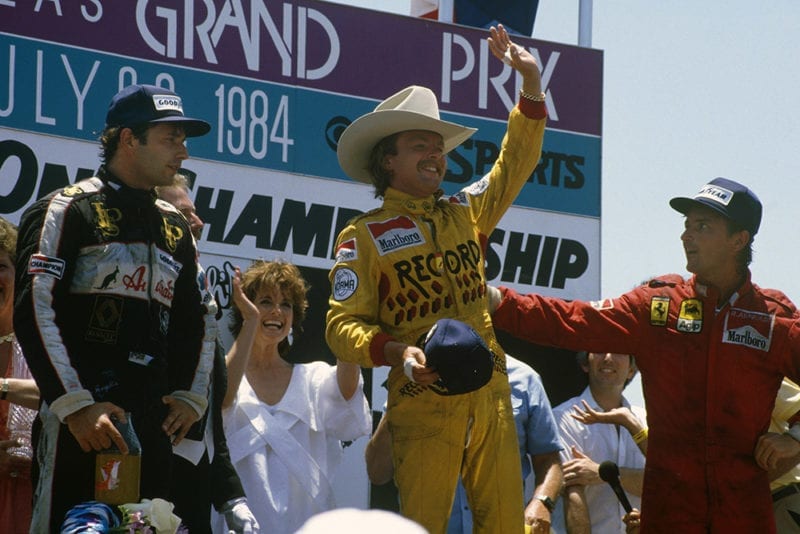
Rosberg celebrates Texas style – he is flanked by Elio de Angelis (left) and Rene Arnoux
Motorsport Images
Thus ended the first Dallas Grand Prix, enjoyed enormously by the huge, enthusiastic crowd which turned out to fry in the 105-deg(F) temperatures under a scorching summer sun. The behind-the-scenes and not-so-behind-the-scenes administrative problems had been a nightmare for all concerned, but the race had gone ahead and could be regarded as a qualified success. Staged at a cooler time of the year, with a more durable track surface laid down in good time, there is little doubt in our mind that it could quickly become the most popular of the World Championship Grands Prix staged in North America. — A.H.
Results
Dallas Grand Prix — Formula Ona — 67 laps — Dallas Fair Ground — 3.901 kilometres par lap — 261.367 kilometres
Too Hot
1st : Keijo Rosberg ……………(Williams FW09/6) ……..2 hr 01 min 22.617 sec — 129.219 kph
2nd : ReneArnoux …………….(Ferrari 126C4/075)……. 2 hr 01 min 45.081 sec
3rd : Elio de Angelis ………….(Lotus 95T/3) ……………..1 lap behind
4th : Jacques Laffite ………….(Williams FW09/3) ………2 laps behind
5th : Piercarlo Ghinzani ……..(Osella FA/1F-02) ……….2 laps behind
6th : Nigel Mansell ……………(Lotus 95T/2) ……………..3 laps behind — not running
7th : Corrado Fabi ……………..(Brabham BT53/2) ……….3 laps behind
8th : Manfred Winkelhock ….(ATS-D7/1) …………………3 laps behind
9th : Niki Lauda …………………(McLaren MP4/2-1) ……..retired on lap 61 — crashed
10th : Alain Prost ……………….(McLaren MP4/2-2) ………retired on lap 57 — crashed
11th : Thierry Boutsen ………..(Arrows A7/2) ………………retired on lap 56 — engine failure
12th : Michele Alboreto ……..(Ferrari 126C4/076) ………retired on lap 55 — crashed
13th : Marc Surer ………………(Arrows A7/1) ………………retired on lap 55 — crashed
14th : Ayrton Senna ………….(Toleman TG184/02) ………retired on lap 48 — driveshaft failure
15th : Jonathan Palmer ……..(RAM 02/02) …………………retired on lap 47 — electrical fault
16th : Nelson Piquet …………(Brabham BT53/4) ………….retired on lap 46 — crashed
17th : Patrick Tambay ……….(Renault RE50/03) ………….retired on lap 26 — crashed
18th : Johnny Cecotto ……….(Toleman TG184/01) ………retired on lap 26 — crashed
19th : Andrea de Cesaris …….(Ligier JS23/04) ……………..retired on lap 16 — crashed
20th : Huub Rothengater ……(Spirit 101/2B) ………………retired on lap 16 — fuel leak
21st : Riccardo Patrese ………(Alfa Romeo 184T/03) …….retired on lap 13 — crashed
22nd : Derek Warwick ……….(Renault RE50/07) ………….retired on lap 11 — crashed
23rd : Stefan Bellof ……………(Tyrrell 012/5) ……………….retired on lap 10 — crashed
24th : Eddie Cheever ………….(Alfa Romeo 184T/02) …….retired on lap 9 — crashed
25th : Francois Hesnault ……..(Ligier JS23/02) ……………..retired on lap 1 — crashed
Fastest lap: Niki Lauda ………..(McLaren MP4/2-1) on lap 22 in 1 min 45.353 sec — 133.302 kph
25 starters — 8 finishers
